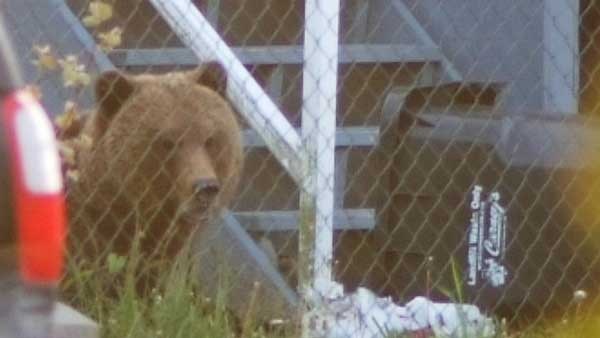By Alison Taylor
The Ministry of Environment is asking Olympic organizers for $300,000 to study grizzly bears in the Callaghan Valley.
The money would be used to help fund a $1.2 million program over three years in which 10 grizzlies in the Squamish-Lillooet region will be radio collared and studied. Three of those grizzlies will be captured, collared and monitored in the Callaghan valley, close to the $119 million Nordic Centre for the Olympic and Paralympic Games.
The Vancouver Organizing Committee for the 2010 Games (VANOC) is hoping to build 25 kilometres of recreational legacy trails next to the venue, in an area known to support grizzlies.
“There are potential risks to the bears and we want to reduce (or remove) those risks by doing the very best management actions and practices,” explained Tom Bell, regional manager of environment stewardship at the ministry of environment.
“We know we have bears in the general Callaghan area. We have a
pretty good idea of where the recreational trails are going to end up being
located… What we want to do with the radio collaring and the ongoing monitoring
is to develop more information so that we can then fine tune our management
actions.”
He said it is not unusual to ask a project developer to kick in
money if the project could affect habitat.
VANOC would not comment on the financial request this week and
instead referred to the EAO process in general terms.
"Now that the public comment
period has closed on the Nordic recreation trails environmental assessment, the
Environmental Assessment Office (EAO) are reviewing all public and agency
comments, concerns and suggestions provided,” said George McKay, director,
environmental approvals. “EAO will next prepare a comprehensive assessment
which will determine any additional mitigation efforts and outline the VANOC
project commitments and assurances for the recreation trails. This process takes
time and it would be premature to comment on any possible changes or additions
to the proposed trail project until this assessment is completed, in about a
month's time."
Bell explained that the information transmitted from the GPS
collars would reveal more intimate details on the grizzly activity in the area
and possibly prompt seasonal trail closures.
It could also fine-tune the design of the trails.
It’s this kind of micro site knowledge that will ensure the
best management of the trails in the future, he added.
Part of that management plan will include public education on
the grizzlies in the area and a plan to control attractants that would bring
grizzlies into the trail network.
The monetary request comes as the public consultation period for the proposed recreation trails in the heart of the Callaghan draws to an end.
It has been a controversial process. Several submissions have been made to the EAO, which will ultimately decide if VANOC gets a permit for the trails or not.
Whistler’s environmental watchdog, the Association of Whistler Area Residents for the Environment (AWARE), has opposed the trails. Whistler council has expressed its concern for wildlife issues.
Cross-country ski organizations are keen to see the trails developed and the centre become a destination ski area. And VANOC says the trails are a key component for an economically viable Nordic centre after 2010.
For Councillor Eckhard Zeidler, who believes VANOC needs more information on the impacts the trails will have on the grizzlies, the financial contribution is a mere fraction of the cost to build the Nordic centre.
“In the overall budget the amount to do the proper work is insignificant,” said Zeidler.
“The cross country community wants to see these trails built properly. The environmental community wants to see them done properly, if they’re built. We’re all on the same page and I think it’s time for VANOC to do the basic level of work that anybody making this kind of an application would have to do.
“For VANOC to support this important program would really show not only their commitment to sustainability but also their commitment to seeing the Nordic centre and proposed legacy trails operate viably in harmony with grizzly bears and wilderness values in the Callaghan valley.”
In addition to the radio-collaring program, the ministry also wants to continue a DNA/hair collection program.
VANOC has been asked to kick in 30 per cent of the overall project cost — essentially to study the Callaghan area. Each year their portion would total $98,000.




